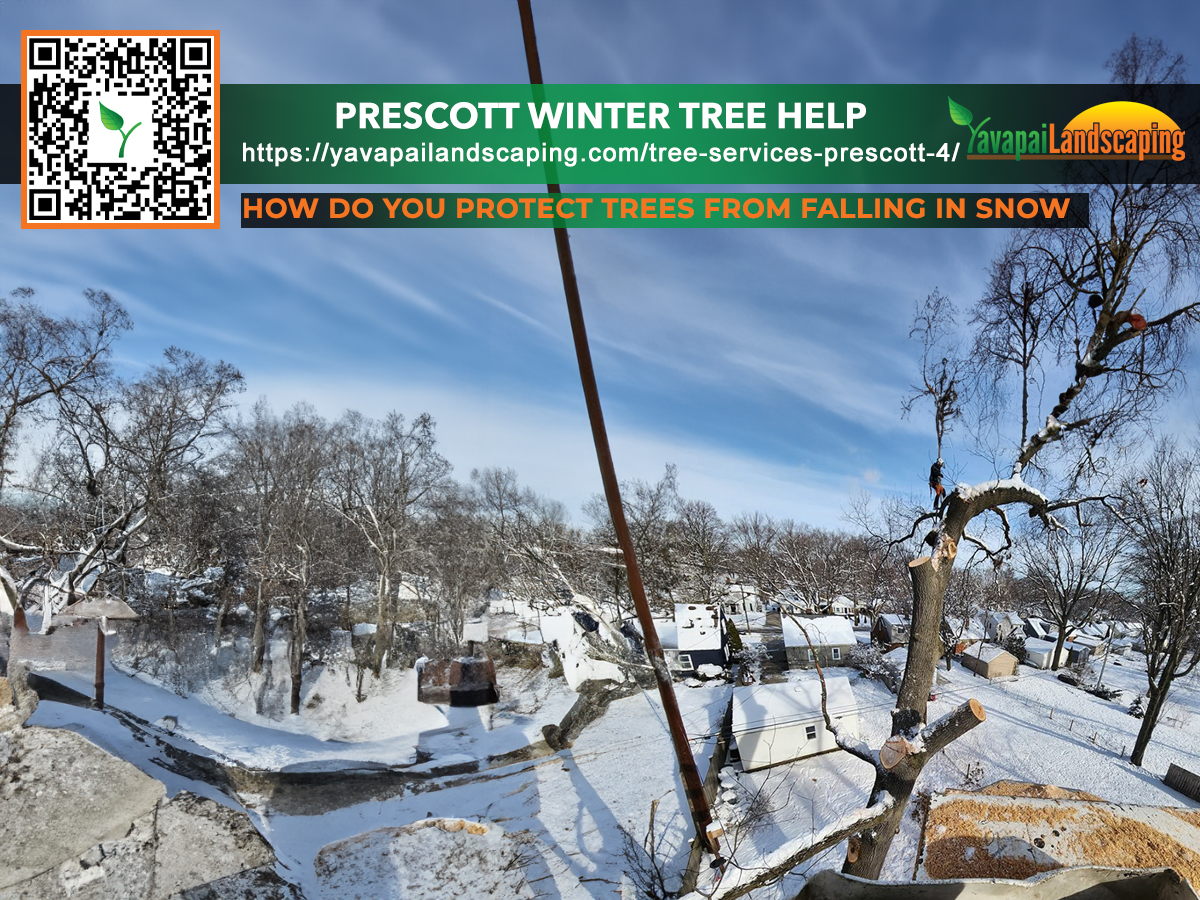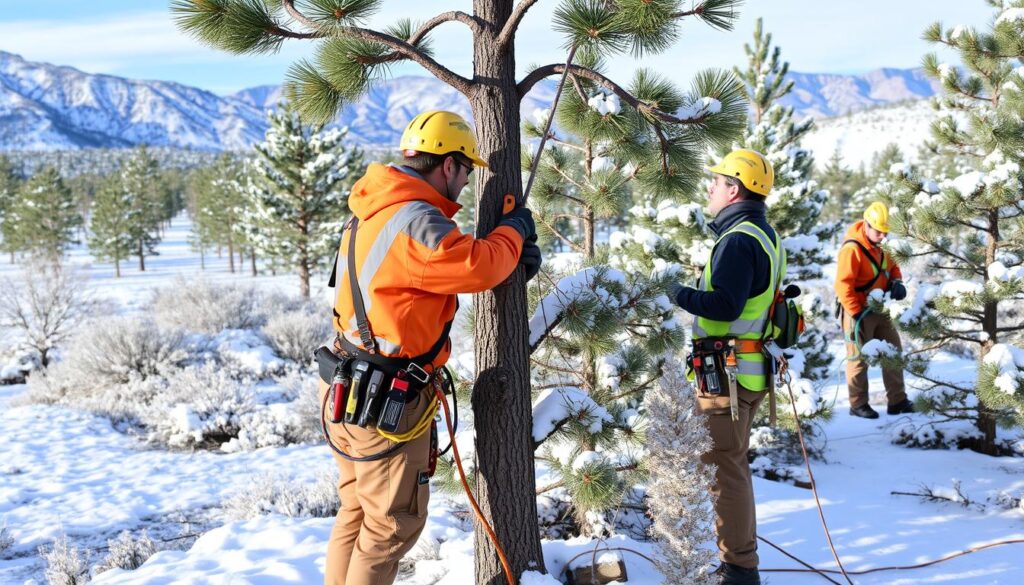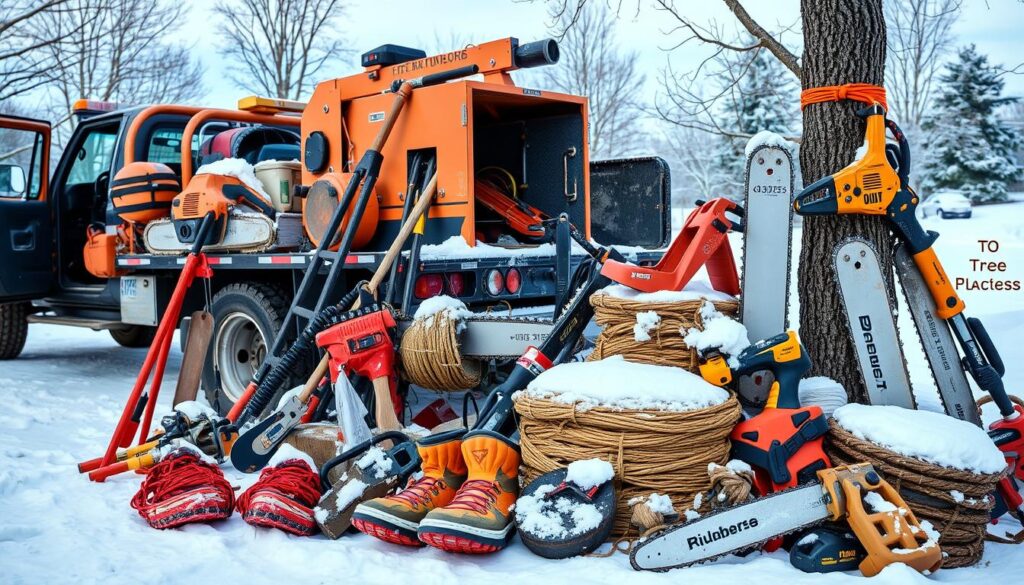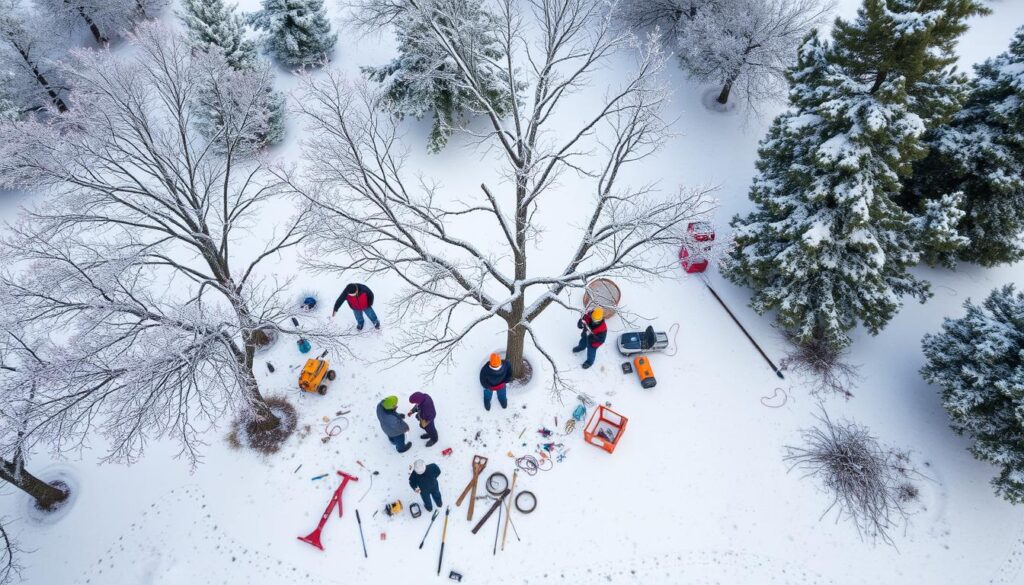
Prescott, Arizona, has a unique winter climate that challenges tree service providers. The city’s cold weather demands special skills from local arborists. Training for winter tree service is key for those working in Prescott’s varied terrain and unpredictable weather.
Arborists in Prescott deal with winter-specific issues. These include heavy snow, ice storms, and freezing temperatures. They need expert knowledge and careful planning to keep trees healthy and safe.
Professional preparedness is crucial for cold region operations. Prescott arborists must adjust their techniques for frozen branches, protecting dormant trees, and handling winter storm damage. This training ensures they work safely and efficiently in harsh conditions.
Key Takeaways
- Prescott’s winter climate requires specialized arborist training
- Cold region operations involve unique challenges for tree care
- Winter-specific issues include snow loads and ice storms
- Arborists need expert knowledge for winter tree maintenance
- Specialized training ensures safe and efficient cold weather work
Understanding Prescott’s Unique Winter Climate Challenges

Prescott’s winter climate is tough for tree service teams. The city’s spot in Northern Arizona makes the weather tricky. They need to plan and adapt carefully.
Microclimate Variations in Northern Arizona
Northern Arizona’s microclimates shape Prescott’s winters. The area’s varied terrain leads to different temperatures and rain. Tree workers face quick changes as they move around.
Impact of Elevation on Winter Service Operations
Elevation matters a lot in Prescott’s winter tree care. Higher places get colder and snow more. This impacts how well equipment works and keeps workers safe. Providers must adjust their methods and tools for each site’s height.
Seasonal Weather Patterns and Service Planning
Knowing Prescott’s weather patterns is crucial for planning. Winter storms can be wild, with lots of snow and ice. Tree care teams need to keep up with weather forecasts and be ready for emergencies. Being flexible with schedules and resources helps meet winter’s demands.
By understanding these challenges, winter tree services can better serve Prescott’s diverse winter needs. This knowledge helps them work more effectively and safely during the cold months.
Essential Safety Protocols for Winter Tree Service Operations
Winter tree service safety is all about strict cold weather protocols and being well-prepared. Tree care experts in Prescott, AZ face special challenges in freezing weather.
Starting with a risk assessment is key to winter tree service safety. Crews check for ice on branches, snow, and other dangers before they begin. This careful planning helps avoid accidents and damage.
Using the right equipment is vital for working in the cold. Workers wear special gear for icy conditions:
- Insulated gloves
- Non-slip boots
- Thermal underlayers
- High-visibility outerwear
But it’s not just about personal gear. Tree service teams also use winter-ready equipment. Chainsaws with heated handles and special lubricants work well in the cold.
Staying prepared means constant training. Crews learn ice climbing, how to spot hypothermia and emergency steps. This thorough training keeps everyone safe.
By following these safety steps, tree care experts in Prescott keep their service top-notch, even in the coldest weather. Don’t pass up the chance to read this remarkable piece.
Winter Tree Service Cold Region Training
Tree service workers in cold areas get special training. They learn how to use equipment, follow safety rules, and get ready for winter emergencies.
Specialized Equipment Operation
This training teaches how to use gear in the cold. Workers learn to safely operate chainsaws, chippers, and aerial lifts on snowy or icy ground. They also learn how to start and keep machines running in freezing temperatures to avoid breakdowns.
Safety Certification Requirements
Safety training is key for winter tree work. It includes:
- Using the right cold-weather gear
- Spotting signs of hypothermia and frostbite
- Safe climbing on icy trees
- Staying away from hidden power lines under snow
Emergency Response Preparation
Tree workers are trained for winter emergencies. They learn to:
- Act fast in storm damage
- Clear roads of fallen trees safely
- Work with local emergency teams
- Give first aid in the cold
This detailed training helps tree service teams work safely and well in winter. It mixes skills in using special equipment, safety training, and emergency prep. This is all needed for tree care in cold climates.
Specialized Equipment and Tools for Winter Tree Care
Winter tree care needs special gear for cold weather. Tree service providers in Prescott, AZ must be ready for the challenges they face.
Cold-Weather Gear and Personal Protection
Workers need the right cold-weather gear to stay safe and warm. This includes insulated boots, thermal layers, and waterproof jackets. They also need gloves that grip well in icy conditions.

Winter-Specific Tree Service Equipment
Equipment for winter tree care must be designed for cold. Chainsaws with heated handles keep hands from freezing. De-icing sprays keep tools working.
Snow blowers clear the area fast. Special pruning tools with long handles let workers avoid icy climbs.
Equipment Maintenance in Freezing Conditions
Keeping equipment in good shape is key in freezing weather. Workers should:
- Store batteries in warm places
- Use winter-grade lubricants
- Dry and clean tools after each use
- Check for ice buildup regularly
By taking care of their tools, workers can count on them all winter.
Professional Certification and Training Requirements
Winter tree service providers in cold areas must have special skills. Arborist certification is key for those in this field. It shows they know how to care for trees in harsh winter weather.
Training for winter tree services teaches important skills for cold weather. Topics include:
- Ice and snow load management
- Cold weather equipment operation
- Frostbite prevention and treatment
- Winter pruning techniques
Arborists also need to keep learning. They get continuing education credits. This keeps them up-to-date with new safety rules and standards. Many places offer online courses to help them stay certified.
There are special certifications for winter tree care. These include:
- Winter Risk Assessment
- Cold Weather Safety
- Emergency Response in Icy Conditions
These certifications help arborists deal with winter’s unique challenges. By getting better at their job, tree care providers can offer great service safely in cold areas.
Winter Tree Assessment and Damage Prevention Techniques
Winter tree assessment is key to keeping trees healthy in cold months. Arborists check for risks and use strategies to prevent damage. This helps protect trees from harsh winter weather.

Ice and Snow Load Evaluation
Checking ice and snow loads is crucial to avoid tree damage. Arborists look for stressed or weak branches. They check if the tree can handle heavy snow and ice.
This helps spot trees at risk of breaking or being uprooted.
Preventive Pruning Strategies
Pruning is important in winter tree care. Removing dead or weak branches lowers the chance of breakage. It also helps air circulate, preventing ice buildup.
Arborists aim to make trees strong against winter storms.
Root System Protection Methods
Keeping the root system safe is essential. Mulching keeps roots warm in cold weather. Good soil drainage stops water from freezing roots.
Arborists might suggest barriers to protect roots from road salt.
Using these methods, tree care experts can lower winter damage risks. This helps trees stay healthy for a long time.
Emergency Response and Storm Damage Protocol
Winter storms can cause a lot of damage to trees. It’s important for tree service providers to act fast. They need a good plan for emergency tree service. Let’s see how they handle winter emergencies.
Rapid Response Team Organization
Tree service companies have special teams ready for storms. These teams are well-trained for winter emergencies. They wear cold-weather gear and have the right tools to work in tough conditions.
Priority Assessment Systems
After a storm, many calls come in. Priority systems help manage these calls. Emergency tree service uses these systems to:
- Identify high-risk situations
- Allocate resources effectively
- Respond to life-threatening scenarios first
This way, they focus on the most urgent needs first.
Communication with Local Authorities
Working with local authorities is crucial. Rapid response teams team up with:
- Police departments
- Fire stations
- Utility companies
This teamwork helps clear roads, fix power, and keep everyone safe.
With a solid emergency plan, tree service providers can reduce damage and restore safety quickly after winter storms.
Seasonal Business Planning and Resource Management
Planning for winter tree services is key in cold areas. Companies must spread their skilled teams across different services. This way, they can meet client needs quickly all winter.
Managing resources well is vital in winter. Tree services need lots of cold-weather gear and special tools. Keeping these in good shape helps avoid shortages when they’re busiest.
Good financial planning is also important. Winter tree services must account for higher costs, like keeping equipment running and training staff. By planning their finances, they can handle winter’s challenges better.
Being ready for winter is essential. Companies that plan well can offer better service and do well financially. This careful planning helps them face winter’s unique challenges head-on.
Yavapai Landscaping Prescott offers complimentary estimates for Prescott and its nearby localities for landscaping and tree services, ranging from tree removal, trimming, stump grinding, land clearing, and storm cleanup to emergency tree care.
